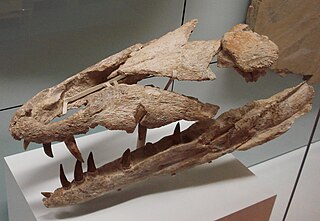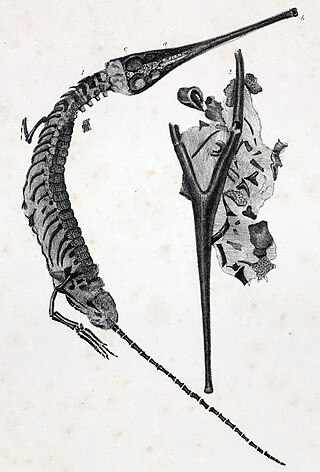
The Oxford Clay is a Jurassic marine sedimentary rock formation underlying much of southeast England, from as far west as Dorset and as far north as Yorkshire. The Oxford Clay Formation dates to the Jurassic, specifically, the Callovian and Oxfordian ages, and comprises two main facies. The lower facies comprises the Peterborough Member, a fossiliferous organic-rich mudstone. This facies and its rocks are commonly known as lower Oxford Clay. The upper facies comprises the middle Oxford Clay, the Stewartby Member, and the upper Oxford Clay, the Weymouth Member. The upper facies is a fossil poor assemblage of calcareous mudstones.

Metriorhynchus is an extinct genus of marine crocodyliform that lived in the oceans during the Late Jurassic. The type species, M. brevirostris was named in 1829 as a species of Steneosaurus before being named as a separate genus by the German palaeontologist Christian von Meyer in 1832. The name Metriorhynchus means "Moderate snout", and is derived from the Greek Metrio- ("moderate") and -rhynchos ("snout").

Metriorhynchidae is an extinct family of specialized, aquatic metriorhynchoid crocodyliforms from the Middle Jurassic to the Early Cretaceous period of Europe, North America and South America. The name Metriorhynchidae was coined by the Austrian zoologist Leopold Fitzinger in 1843. The group contains two subfamilies, the Metriorhynchinae and the Geosaurinae. They represent the most marine adapted of all archosaurs.

Thalattosuchia is a clade of mostly marine crocodylomorphs from the Early Jurassic to the Early Cretaceous that had a cosmopolitan distribution. They are colloquially referred to as marine crocodiles or sea crocodiles, though they are not members of Crocodilia and records from Thailand and China suggest that some members lived in freshwater. The clade contains two major subgroupings, the Teleosauroidea and Metriorhynchoidea. Teleosauroids are not greatly specialised for oceanic life, with back osteoderms similar to other crocodyliformes. Within Metriorhynchoidea, the Metriorhynchidae displayed extreme adaptions for life in the open ocean, including the transformation of limbs into flippers, the development of a tail fluke, and smooth, scaleless skin, and probably gave live birth, seemingly uniquely among archosaurs.

Teleosauridae is a family of extinct typically marine crocodylomorphs similar to the modern gharial that lived during the Jurassic period. Teleosaurids were thalattosuchians closely related to the fully aquatic metriorhynchoids, but were less adapted to an open-ocean, pelagic lifestyle. The family was originally coined to include all the semi-aquatic thalattosuchians and was equivalent to the modern superfamily Teleosauroidea. However, as teleosauroid relationships and diversity was better studied in the 21st century, the division of teleosauroids into two distinct evolutionary lineages led to the establishment of Teleosauridae as a more restrictive family within the group, together with its sister family Machimosauridae.
Purranisaurus is an extinct genus of marine crocodyliform from the Middle to Late Jurassic period of Chile and Vaca Muerta of Argentina. Rusconi originally regarded Purranisaurus potens to be a plesiosaur; however, Gasparini demonstrated that it was in fact a metriorhynchid crocodyliform, and that may be a junior synonym of Metriorhynchus. It was about 3.3 m (11 ft) long.

Rhacheosaurus is an extinct genus of marine crocodyliform belonging to the family Metriorhynchidae. The genus was established by Christian Erich Hermann von Meyer in 1831 for skeletal remains from the Tithonian of Germany. It was a relatively small reptile, measuring between 1.39 and 1.57 m long.

Suchodus is an extinct genus of marine crocodyliform from the Middle to Late Jurassic period of England and France. It measured between 3.3 and 4.7 m in total body length.

Cricosaurus is an extinct genus of marine crocodyliforms of the Late Jurassic. belonging to the family Metriorhynchidae. The genus was established by Johann Andreas Wagner in 1858 for three skulls from the Tithonian of Germany. The name Cricosaurus means "Ring lizard", and is derived from the Greek Krikos- ("ring") and σαῦρος -sauros ("lizard"). It was a relatively small reptile, with C. suevicus and C. araucanensis measuring 2 m (6.6 ft) and 3.2 m (10 ft) in total body length, respectively.

Steneosaurus is a dubious genus of teleosaurid crocodyliform from the Middle or Late Jurassic of France. The genus has been used as a wastebasket taxon for thalattosuchian fossils for over two centuries, and almost all known historical species of teleosauroid have been included within it at one point. The genus has remained a wastebasket, with numerous species still included under the label ‘Steneosaurus’, many of which are unrelated to each other.

The Marnes de Dives is a geological formation in Normandy, France. It dates back to the upper part of the Callovian stage of the Middle Jurassic. And is partially equivalent to the Oxford Clay in England. It predominantly consists of ooidal marl, rich in pyrite and lignite, interbedded with thin limestone horizons. It is best exposed at the base of the Falaises des Vaches Noires as well as the foreshore at low tide. It is known for its fossils, notably those of ammonites, marine crocodiles and fragmentary remains of dinosaurs, mostly theropods.

Gracilineustes is an extinct genus of marine crocodyliform that lived in the oceans during the Middle to Late Jurassic. Gracilineustes was a carnivore that spent much, if not all, its life out at sea. It was a small reptile, with G. leedsi measuring 2.25–3.11 m (7.4–10.2 ft) long and G. acutus measuring 3.77 m (12.4 ft) long.

Metriorhynchoidea is an extinct superfamily of thalattosuchian crocodyliforms from the Early Jurassic to the Early Cretaceous of Europe, North America and South America. Metriorhynchids are fully aquatic crocodyliforms. Named by Fitzinger, in 1843, it contains the basal taxa like Teleidosaurus, Zoneait and Eoneustes and the family Metriorhynchidae. An unnamed taxon is known from Chile.

Torvoneustes is an extinct genus of metriorhynchid thalattosuchian. It is known from skull and postcranial remains found in the Kimmeridge Clay Formation of Dorset and Wiltshire, England, the Virgula Marls of Switzerland and also from Oaxaca, Mexico . The holotype skull of the type species was initially assigned to the species Metriorhynchus superciliosus. Postcranial remains were later discovered from the same quarry as the skull, and then these specimens were recognised as belonging to a new species of Dakosaurus, as D. carpenteri. The species was named to honour Simon Carpenter, an amateur geologist from Frome in Somerset, who discovered the fossils.

Macrospondylus is an extinct genus of machimosaurid teleosauroid crocodyliform from the Early Jurassic (Toarcian) of Europe. Fossils are known from the Posidonia Shale of Germany, the Whitby Mudstone of the United Kingdom, and the "schistes bitumineux" of Luxembourg.

Geosaurinae is a subfamily of metriorhynchid crocodyliforms from the Middle Jurassic to the Early Cretaceous of Europe, North America and South America. Named by Richard Lydekker, in 1889, it contains the metriorhynchids Suchodus, Purranisaurus, Neptunidraco, Tyrannoneustes, Torvoneustes, Dakosaurus, Geosaurus and Plesiosuchus. The last five taxa form a tribe within Geosaurinae, the Geosaurini. Geosaurinae is one of two subfamilies of Metriorhynchidae, the other being Metriorhynchinae.

Lemmysuchus is a genus of machimosaurid thalattosuchian from the Middle Jurassic Callovian of England and France. Like many other teleosauroids from Europe, it has had a convoluted taxonomic history.

Teleosauroidea is an extinct superfamily of thalattosuchian crocodyliforms living from the Early Jurassic to the Early Cretaceous. It is phylogenetically defined by Mark T. Young and colleagues in 2024 as "the largest clade within Thalatttosuchia containing Teleosaurus cadomensis, but not Metriorhynchus brevirostris. This group contains two main families, the more piscivorous and gracile Teleosauridae and the more macropredatory and robust Machimosauridae.

Machimosauridae is an extinct family of teleosauroid thalattosuchian crocodyliforms. The family was first identified in 2016, when fossils of teleosauroid thalattosuchians, including an indeterminate close relative of Lemmysuchus and Machimosaurus, were described from the Middle Jurassic (Bathonian) of Morocco. The family was largely expanded in 2020 when the systematics of Teleosauroidea were re-reviewed. Members of this family generally were larger than the teleosaurids.

Thalattosuchus is an extinct genus of marine crocodyliform that lived in the oceans during the Middle to Late Jurassic. Thalattosuchus was named in 2020. Thalattosuchus was a carnivore that spent much, if not all, its life out at sea. No Thalattosuchus eggs or nests have been discovered, so little is known of the reptile's life cycle, unlike other large marine reptiles of the Mesozoic, such as plesiosaurs or ichthyosaurs which are known to have given birth to live young out at sea. Where Thalattosuchus mated, whether on land or at sea, is currently unknown. The name Thalattosuchus means "sea crocodile".



















